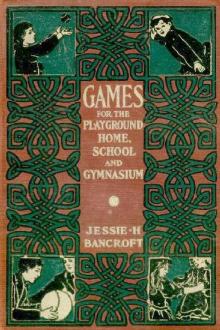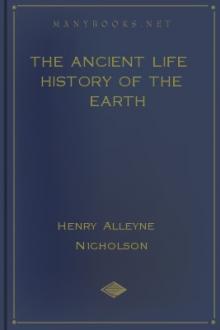Games for the Playground, Home, School and Gymnasium by Jessie Hubbell Bancroft (top novels of all time .txt) 📕

- Author: Jessie Hubbell Bancroft
- Performer: -
Book online «Games for the Playground, Home, School and Gymnasium by Jessie Hubbell Bancroft (top novels of all time .txt) 📕». Author Jessie Hubbell Bancroft
The leader says, "Simon says, 'Thumbs up!'" whereupon he places his own fists on the table before him with the thumbs upward. The players must all do likewise. The leader then says, "Simon says, 'Thumbs down!'" whereupon he turns his own hands over so that the tips of the thumbs touch the table, the others imitating him. He may then say, "Simon says, 'Thumbs wiggle waggle!'" whereupon he places his fist on the table with the thumbs upward and moves the thumbs sideways, the players imitating him.
If at any time the leader omits the words "Simon says," and goes through the movements simply with the words "Thumbs up!" "Thumbs down!" or "'Wiggle waggle!" the players must keep their hands still and not imitate his movements. Any player imitating him under these circumstances must either pay a forfeit or become leader, or both, as may be decided on beforehand.
SKETCHES3 to 60 players.
Schoolroom; parlor.
The game here described for use with history may be used simply as a diversion in describing animals or any inanimate objects; or it may be used to correlate with English (authors), picture study, etc.
Each player is provided with a sheet of paper and pencil and writes a description of some historical character; the object being to give a description that shall be perfectly truthful and yet puzzling or misleading for the other players who are to guess the identity of the character in the writer's mind.
One player is called on to read his description. The other players may have the privilege of asking questions that may be answered by "Yes" or "No" only; but it is considered much more of an honor to guess correctly without this assistance. The one guessing the character correctly reads his description next. A description for instance might read:—
"The person whom I would describe was a very tall man; very vigorous; used an ax on occasion; had much to do with legislators; was widely known outside of his native country, and has been the subject of many biographies."
As this description would apply equally to Washington, Lincoln, Gladstone, and several others who might be mentioned, there is opportunity for considerable guessing before the right character be found.
TIDBITS FARMER (THE)5 to 30 players.
House party.
Each player should be given a card or slip of paper on which the following verses are written, the last of each line being left blank. The game consists in filling in the blank spaces each with a double letter of the alphabet, as indicated in parentheses. The player wins who has the largest number correct.
He hears the chatter of the (JJ) As they each other (TT) And sees that when a tree de (KK) It makes a home for (BB)
A yoke of oxen will he (UU) With many haws and (GG) And their mistakes he will ex (QQ) When plowing for his (PP)
He little buys but much he se (LL) And therefore little (OO) And when he hoes his soil spe (LL) He also soils his h (OO) TIP TAP TOE
2 to 8 players.
Indoors; out of doors.
INDOORS.—A circle is drawn on a slate or paper, the size of it varying with the number of players, a larger circle being desirable for a large number of players. This circle is intersected with straight lines, so that it is divided into a series of wedge-shaped spaces, the number of lines and spaces being also at the discretion of the players, the larger the number of players the larger the number of spaces desirable and the greater the variation in scoring. In each of these spaces numbers are written in consecutive order, one for each space, 1, 2, 3, 4, etc., or the numbers may be done in multiples of five,—5, 10, 15, 20, etc. The players take turns in rotation. The one whose turn it is shuts his eyes, takes a pencil, circles it around over the diagram while he says the following verse:—
Three jolly sailor boys all in a row."
At the close of the verse the player places the point of the pencil on the diagram, still with his eyes closed. He then opens his eyes, and should the pencil have touched one of the numbered spaces, he marks down to his score the number written in that space, and crosses out that figure on the diagram. Thereafter that space does not count in playing. Should the pencil touch a dividing line or the line forming the circumference of the circle, or fall outside of the circle, or fall in a space in which the number has been crossed out, the player scores nothing, and loses his turn, the next one taking up the play.
When all of the spaces have been crossed out, the player wins who has the largest score, but should any player at any time touch his pencil to the center of the circle, he wins the game.
OUT OF DOORS.—This game may be played out of doors by drawing the diagram on the earth with a sharpened stick, which is used afterwards as a pointer as a pencil is used on the paper diagram. If on hard earth the figures may be marked in the spaces as on a paper diagram, but the diagram should be drawn considerably larger than when on paper.
This is an admirable game for playing on the hard sand of the seashore. In that case little pebbles or shells are placed in the different spaces instead of numerals; one in the first space, two in the second, three in the third, etc. When a player places his stick or pointer in a space he removes the pebbles from that place to a little pile, and the score is counted at the end by counting this pile of pebbles. Any space from which the pebbles have been removed is thereafter out of the game, as when the figures are crossed out on the paper diagram.
This game is supposed to have originated in early methods of allotting land.
UP, JENKINS!6 to 20 or more players.
Parlor; schoolroom.
This is one of the most popular current games among young people, being usually played to the accompaniment of much laughter and intense interest. It consists in the guessing by opposing parties of the hand under which a coin is hidden.
The players are divided into two parties. Each party has a captain, each player being captain in turn during successive rounds of the game. The players gather around a table, one party on one side and the others opposite. A coin, usually a quarter, is passed from hand to hand under the table by one of the parties in an endeavor to conceal from the opponents which individual holds it. The leader of the opposite party then calls, "Up, Jenkins!" when all of the hands of his opponents are brought from under the table and held up with palms outward toward the guessing party, fingers closed down tightly over the palms, the quarter being hidden in one of the hands. The opponents may look at the hands from their side of the table in this way as long as they choose. The leader then commands "Down, Jenkins!" when the hands are slammed down simultaneously flat on the table, palms downward. This is done with enough noise to disguise the clink of the coin striking the table. The object of the game is for the opponents (those not having the coin) to guess under which hand the coin is laid, each hand supposed not to have it being ordered off the table. The captain of the guessing party, who alone may give these orders (though his players may assist him with suggestions), calls for the lifting of one specified hand at a time. The player named must lift the hand indicated, and that hand is thereafter to be taken from the table.
If the guessing party can be successful in thus eliminating all of the empty hands so that the coin is left under the last hand, they are considered to have won, and the coin passes to them for the next round. If the coin be disclosed before the last hand be reached, the side holding it adds to its score the hands remaining on the table that were not ordered off. The side wins which has the highest score when the play stops, the time limits being indefinite.
For the schoolroom see also an adaptation called Hands up—Hands down.
WHAT IS MY THOUGHT LIKE?5 to 30 players.
Children's party; house party; playground.
The players are seated in a circle or any convenient group. One of the number decides upon a "thought"; that is, he thinks of some person, object, or abstraction, without telling the others what it is. He then asks of each in turn, "What is my thought like?" Each answers anything he chooses. The first player then declares what his thought was, and asks of each, "Why is—(naming the object he thought of) like—(whatever such player answered)?" Each must find some likeness, however absurd, or pay a forfeit. For instance, the answers around the circle might be, "Your thought is like an umbrella," "like Napoleon," "Pinafore," "sadness," "my necktie," "a rose," etc. The questioner then says, "I thought of a lead pencil. Why is a pencil like an umbrella?" "Because it is oftenest black." The pencil may be like Napoleon because it can make a mark; like a rose because it is sometimes cut, etc. If any one happens to answer to the first question, "a pencil" (or whatever was thought of), he also must pay a forfeit.
WOODLAND LOVERS (THE)5 to 30 or more players.
House party.
Each player is given a paper on which the following is written or dictated, the words in parentheses being omitted and a blank space left. The game consists in each player filling in these blank spaces with the name of some tree. The host or hostess at the end reads this list of words in order, the player winning who has the largest number correct. The same tree may be mentioned more than once.
He took her little hand in his own big (palm). "I love (yew), dear," he said simply. She did not (sago) away, for it had been a case of love at first sight. She murmured something in (aloe) voice. They had met one day upon a sandy (beech), and from that (date) onward, they cared not a (fig) for the outside world. Her name was (May Ple). She was a charming girl. Rosy as a (peach); (chestnut) colored hair; (tulips) like a (cherry); skin a pale (olive). In fact, she was as beautiful (as pen) or brush ever portrayed. The day he met her she wore a jacket of handsome (fir). He was of Irish descent, his name being (Willow) 'Flaherty. He was a (spruce) looking young fellow. Together they made a congenial (pear). But when did the course of true love ever run smooth? There was a third person to be considered. This was (paw paw). Both felt that, counting (paw paw) in, they might not be able to (orange) it. What if he should refuse to (cedar)! Suppose he should (sago) to her lover? And if he should be angry, to what point won't a (mango)? Well, in that case





Comments (0)